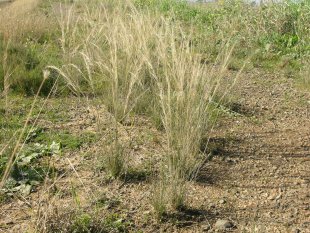
Rough speargrass or Corkscrew grass
SCIENTIFIC NAME: Austrostipa scabra (formerly Stipa scabra)
CATEGORY: C3 perennial
IDENTIFICATION TIPS
- Tufted, yearlong green perennial to 80cm tall
- Leaves are very fine, long, rolled and usually rough to touch
- Seedhead is a moderately contracted or open panicle to 30cm long
- Spikelet is 10-15mm long, sharp pointed and with a long scythe-shaped awn
- Flowers from spring to autumn
CLIMATIC & SOIL REQUIREMENTS
- Occurs on rocky outcrops, westerly aspects and lighter textured well-drained soils
- Commonest where there is low ground cover and little soil depth
- Highly drought and frost tolerant
GRAZING & NUTRITIONAL VALUE
- Low to moderate grazing value
- Digestibility of green leaf is usually <60%
- Crude protein 3–17%
MANAGEMENT STRATEGIES
- Productive in early spring and summer, but develops a high percentage of dead leaf, at which stage it has low palatability and quality
- Palatable only when young
- The seed is sharp and can penetrate fleeces and skin or cause eye damage
- Suited to lightly stocked situations. Resting at flowering will aid persistence at higher stocking rates
- Heavy grazing or slashing at early flowering will reduce seed contamination, but may reduce the populations over time
- Has little response to fertiliser and tends to decline under super and clover application due to increased competition
SIMILAR PLANTS
- Plume grasses (Dichelachne micrantha and D. crinita) have dense seedheads and broader leaves
- Snow grass (Poa sieberiana) is vegetatively similar, but doesn’t have awns in the seedhead
- Serrated tussock (Nassella trichotoma) can look very similar when not in flower; but has rolled leaves, a small, membranous ligule and pink, fluffy seedhead
- Chilean needle grass (N. neesiana) can look similar, especially when in flower, but has a tiny ring of tissue topped by short hairs between the seed and awn

(Habit: H Rose)

